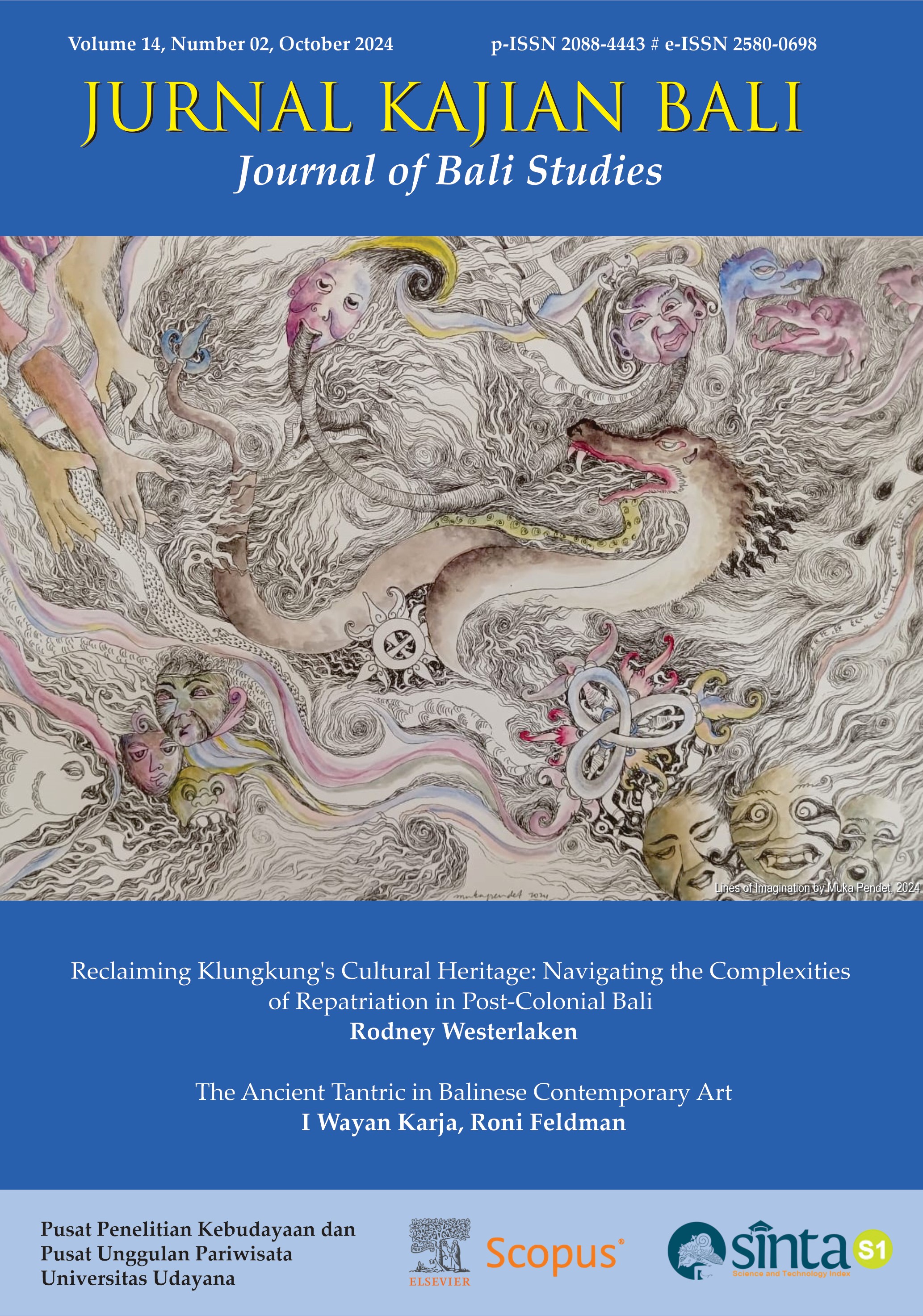Reclaiming Klungkung's Cultural Heritage: Navigating the Complexities of Repatriation in Post-Colonial Bali
Abstract
This article examines the complexities of repatriating objects from Bali's Klungkung Court seized by Dutch forces in 1908. It argues that repatriation, often conducted as restitution between nations, fails to fully consider local communities' needs. Through a case study of five artifacts, the article explores historical, cultural, and ethical dimensions, highlighting repatriation challenges. It emphasizes engaging local stakeholders for an equitable process. Returning these artifacts can rectify historical injustices, uphold cultural sovereignty, and foster reconciliation between the Netherlands and Indonesia, despite challenges like provenance research and ownership disputes. Repatriation remains vital for addressing colonial legacies and promoting cultural justice by acknowledging wrongs, aiding healing, empowering descendants, and sustaining cultural practices. The study concludes that repatriation is a continual, complex process requiring commitment to justice, reconciliation, and cultural autonomy, focusing on the perspectives of communities from which objects were taken.
Downloads
References
Antara, A. A. K. A., Gelgel, I. P., & Utama, I. W. B. (2019). Ideology behind the war of Puputan Badung. International Journal of Linguistics, Literature and Culture, 5(6), 28-35. https://doi.org/10.21744/ijllc.v5n6.749
Ardhana, I. K. (2013). Pandangan Lokal Versus Barat Tentang Puputan Badung: Ekspansi Imperialisme Modern Belanda dalam Konteks Bali. Jurnal Kajian Bali, 3(1), 65-86.
Bataviaasch Genootschap van Kunsten en Wetenschappen. (1908). Notulen van de Algemeene en Directievergaderingen van het Bataviaasch Genootschap van Kunsten en Wetenschappen (Vol. XLVI). Batavia.
Beurden, J. (2017). Treasures in trusted hands: Negotiating the future of colonial cultural objects. Sidestone Press.
Bloembergen, M., & Eickhoff, M. (2020).The politics of heritage in Indonesia: A cultural history. Cambridge University Press.
Braun, V., & Clarke, V. (2006).Using thematic analysis in psychology.Qualitative Research in Psychology, 3(2), 77-101.
Brinkgreve, F. (2006). W.O.J. Nieuwenkamp en zijn vorstelijke leeuwendoosje. Aziatische Kunst, 36(3), 2-15. https://doi.org/10.1163/25431749-90000082
Direktorat Jenderal Kebudayaan RI (2023). Siaran Pers: Serah Terima Koleksi Benda Seni Bersejarah Indonesia dari Pemerintah Belanda. 10 Juli. https://kebudayaan.kemdikbud.go.id/wp-content/uploads/2023/07/Siaran-Pers.pdf
Elizondo, E. (2023). The history of the Elgin marbles and the ethics of repatriation in the 21st
century.
Geertz, C. (1980).The Theatre-State in Nineteeth-Century Bali. Princeton: Princeton
University Press
Gonçalves-Ho Kang You, L. (2021). Advies koloniale collecties en erkenning van onrecht.
https://www.raadvoorcultuur.nl/documenten/adviezen/2020/10/07/advies-koloniale-
collecties-en-erkenning-van-onrecht
Historia.id. 2023. Katalog Pameran Repatriasi: Kembalinya Saksi Bisu Peradaban
Nusantara. https://historia.id/microsite/katalog-pameran-repatriasi
Kim, E. (2024). Returning the Benin bronzes: An analysis under international and U.S. law.
Notre Dame Journal of International & Comparative Law, 14(2), Article 5.
https://scholarship.law.nd.edu/ndjicl/vol14/iss2/5
Laksemi, S. (2009). Makna Simbol Gelar Raja Dalam Masyarakat Adat Bali. ITB
Journal of Visual Art and Design. 3. 43-56. 10.5614/itbj.vad.2009.3.1.4.
Maslan, M. R. (2023, July 14). Ketika keris Puputan Klungkung pulang kampung. Detik
News. https://news.detik.com/x/detail/intermeso/20230714/Ketika-Keris-Puputan-
Klungkung-Pulang-Kampung/
Mooren, J., Stutje, K., & Vree, van, F. (2022). Sporen: Onderzoek naar herkomstgeschiedenis en betekenisgeving van culturele projecten en collecties verworven in koloniale situaties.
National Museum of Indonesia.(n.d.). Chest pendant [Exhibition label]. Jakarta, Indonesia.
National Museum of World Cultures. (n.d.) https://collectie.wereldmuseum.nl/
Parimartha, I. G. (2011). Aktualisasi Nilai-nilai 'Puputan' dalam Pembangunan Karakter
Bangsa. Jurnal Kajian Bali, 1(2), 130-139.
Pringle, R. (2004). A short history of Bali, Indonesia's Hindu realm. Allen & Unwin.
Quist, T. (2022). Provenance report regarding Staatsiekeris - keris (Ceremonial Keris).
(PPROCE provenance reports; No. 31).
Reichle, N. (Ed.). (2010). Bali: Art, ritual, performance. Asian Art Museum.
Rijksmuseum. (n.d.). Ivoren doos in de vorm van een gevleugelde leeuw.
https://www.kvvak.nl/collectie/AK-MAK-280/
Robinson, G. (1995). The dark side of paradise: Political violence in Bali. Ithaca: Cornell
University Press.
Ter Keurs, P. (2006). Indonesia: The Discovery of the Past. In E. S. Hardiati & P. ter Keurs
(Eds.), Leiden: KIT Publishers.
Titi, C. (2023). Elgin and the marbles. In The Parthenon marbles and international law (pp.
63-95). Springer International Publishing.
Smith, L. T. (2012). Decolonizing methodologies: Research and indigenous peoples (2nd
ed.). Zed Books.
Stichting Nationaal Museum voor Wereld Culturen. (2024). NMVW-collectie. Retrieved [29-05-2024], from https://collectie2.wereldculturen.nl/
UNESCO. 2009. Return of cultural objects: the Athens conference. Museum International, Vol. 61, Issue 1-2. https://unesdoc.unesco.org/ark:/48223/pf0000182992.locale=en
Uzuegbu, J. O., Halilu, A., & Tella, A. O. (2024). Community museums as holding centres for returned Nigerian cultural heritage.
Vickers, A. (2013). Bali: A paradise created. Tuttle Publishing.
Wiener, M. J. (1995). Visible and invisible realms: Power, magic, and colonial conquest in Bali. University of Chicago Press.
Wijaya, I. N. (2023). Diskontinyuitas Sejarah Bali Abad XIX: Alternatif Mempelajari Masa Lampau melalui Pendekatan Postmodern. Jurnal Kajian Bali, 13(2), 692-716. https://doi.org/10.24843/JKB.2023.v13.i02.p15
Wirayudha, R. (2023, December 8). Pulangnya keris pusaka warisan Puputan Klungkung. Historia. https://historia.id/kultur/articles/pulangnya-keris-pusaka-warisan-Puputan-klungkung-vZ11x
Yin, R. K. (2018). Case study research and applications: Design and methods (6th ed.). SAGE Publications.

This work is licensed under a Creative Commons Attribution 4.0 International License.



















